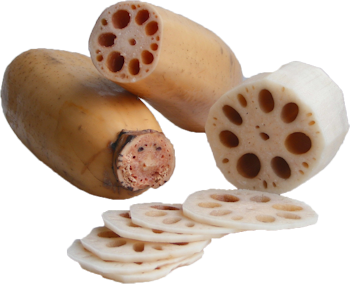|
Lotus root is one
of the moderate calorie root vegetables. 100 g root-stem provides about 74
calories. Nevertheless, it composed of several health benefiting
phyto-nutrients, minerals, and vitamins.
Lotus rhizome is
very good source dietary fibre; 100 g flesh provides 4.9 g or 13% of
daily-requirement of fibre. The fibre, together with slow digesting complex
carbohydrates in the root help reduce blood cholesterol, sugar, body weight and
constipation conditions.
Lotus root is one
of the excellent sources of vitamin C. 100 g root provides 44 mg or 73% of
daily-recommended values. Vitamin C is a powerful water soluble anti-oxidant.
It is required for the collagen synthesis inside the human body. Collagen is
the main structural protein inside the body, required for maintaining integrity
of blood vessels, skin, organs, and bones. Regular consumption of foods rich in
vitamin C helps the body protect from scurvy, develop resistance against viral
infections, boosting of immunity, wound healing and to scavenge cancer causing
harmful free radicals from the body.
In addition, the
root contains moderate levels of some of valuable B-complex group of vitamins
such as pyridoxine (vitamin B-6), folates, niacin, riboflavin, pantothenic
acid, and thiamin. Pyridoxine (vitamin B-6) acts as a coenzyme in the
neuro-chemical synthesis in the brain which influences mood. Adequate
pyridoxine levels help control nervous irritability, headache, and tension. It also
cuts heart-attack risk by controlling harmful homocysteine levels in the blood.
Further, the root
provides healthy amounts of some important minerals like copper, iron, zinc,
magnesium, and manganese. Copper is a cofactor for many vital enzymes, including
cytochrome c-oxidase and superoxide dismutase (other minerals function as
cofactors for this enzyme are manganese and zinc). Along with iron, it is also
required in the production of red blood cells.
Crunchy, neutral
yet delicate flavour of root lotus is because of its optimum electrolyte
balance. It composes agreeable ratio of sodium to potassium at the value 1:4.
While sodium gives sweet taste to the root, potassium acts to counter negative
effects of sodium by regulating heart rate and blood pressure.
Blood Circulation: Lotus root can be a wonderful way to stimulate the circulation
of your blood to increase oxygenation of your organs and generally increase
functionality and energy levels. The iron and copper content in lotus roots is
significant, and they are both integral parts of red blood cell production,
reducing chances of developing anaemic symptoms and increasing vitality and
blood flow.
Mental Clarity and
Mood: One of the elements of the vitamin B complex is pyridoxine. It
directly interacts with neural receptors in the brain that influence mood and
mental states. It also controls irritability, headaches, and stress levels.
Lotus flowers are often connected with peace and tranquillity, but it is the
lotus root which really delivers the peace people are looking for!
Blood Pressure: The significant levels of potassium found in lotus root
ensures a proper balance between the fluids in the body and also counteracts
the effects of sodium in our bloodstream. Potassium is a vasodilator, meaning
that it relaxes blood vessels and by lessening the contraction and rigidity, it
increases blood flow and reduces the strain on the cardiovascular system.
Potassium is also an essential component of neural activity and the passage of
fluid and blood in the brain.
Digestion: The woody, fleshy lotus root is packed with dietary fibre, which
is known to bulk up stool and expedite bowel movements. Lotus root can reduce
symptoms of constipation, while optimizing nutrient absorption through the
secretion of digestive and gastric juices and stimulating peristaltic motion in
the smooth intestinal muscles to facilitate easy and regular bowel movements.
Vitamin C Content: When we talk about the vitamin content of lotus root, vitamin C
is certainly the most prominent. 100 grams of lotus root contains 73% of your
daily requirement of this powerful antioxidant vitamin. Vitamin C is an
important component of collagen, which maintains the integrity and strength of
our blood vessels, organs, and skin, and is also a major stimulant for the
immune system. Furthermore, vitamin C can neutralize free radicals in the body,
which are dangerous by-products of cellular metabolism connected to causing
conditions like cancer and heart disease!
Heart Health: Along with the vasodilating potential of potassium and the
cholesterol-scrubbing ability of dietary fibre, the pyridoxine content in lotus
root also controls the levels of homocysteine in the blood, which is directly
connected to causing heart attacks!
Weight Regulation: Lotus roots are a good option for people trying to manage their
weight. By including low-calorie foods that are high in nutrients and fibre,
you are able to get all the nutrients you need, and still feel full, so you
reduce chances of overeating and can manage obesity.
Vitamin A Content: This is another essential vitamin found in lotus roots, which
has been proven to improve the health of the skin, hair, and eyes. It has major
antioxidant capabilities and can prevent macular degeneration and other ocular
conditions, help wounds heal faster, and clear up skin conditions and
inflammation. Lotus roots are an all-around bonus for your health!
A Few Words of Caution: There are no inherent risks, but some people choose to eat lotus
roots raw, which can spread parasites or bacterial infections. Therefore,
always cook lotus roots before eating or preparing them in other forms.
|

